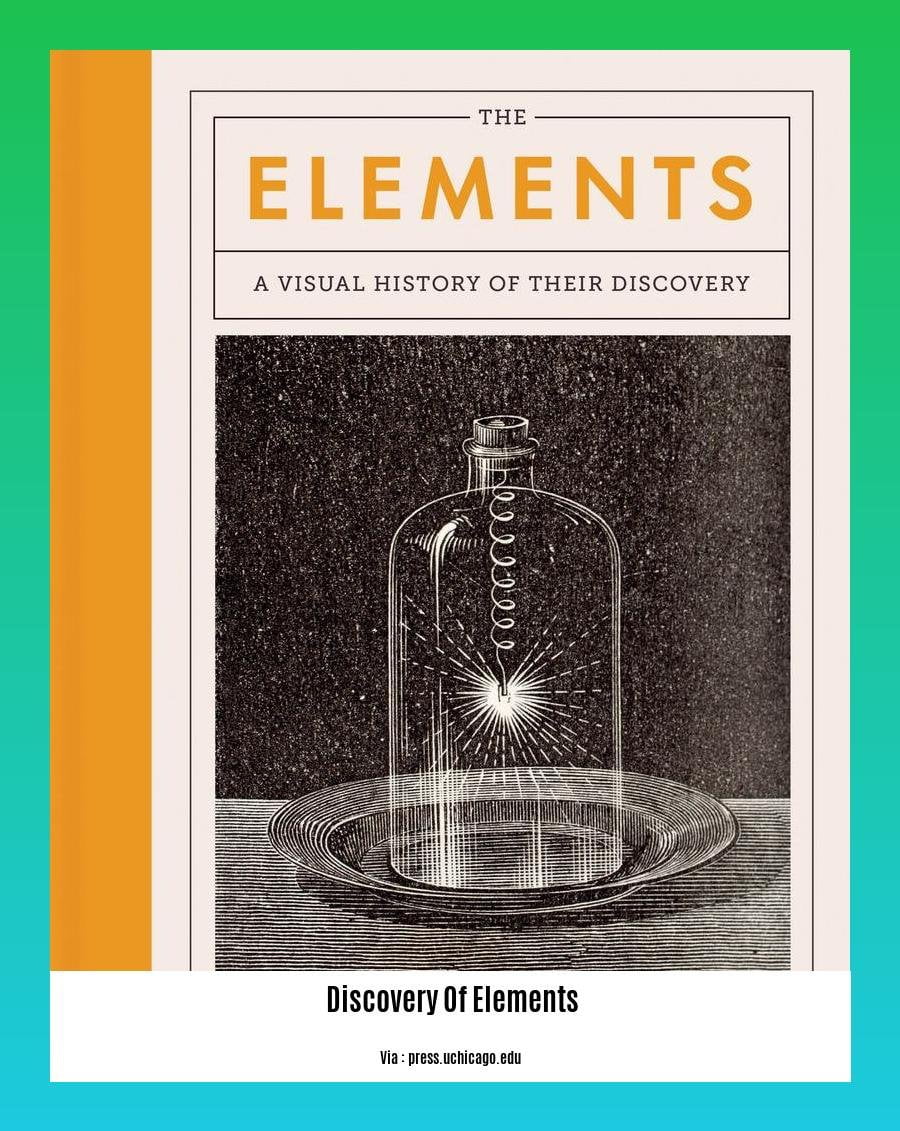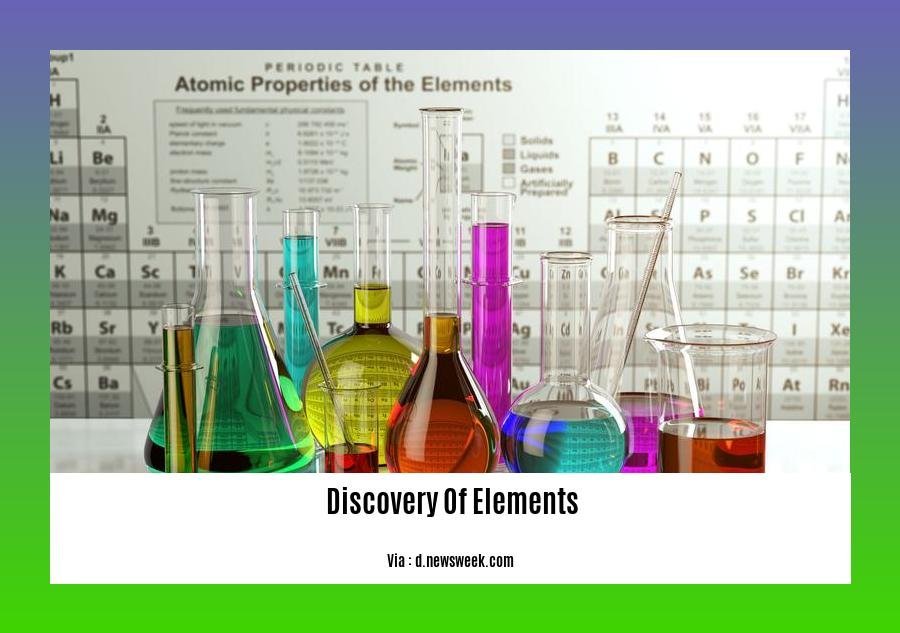Embark on a captivating journey through the discovery of elements, the fundamental building blocks of our universe. From the dawn of alchemy to the cutting-edge techniques of modern science, uncover the fascinating stories behind the identification and isolation of each element in [The Discovery of Elements: A Journey Through Chemistry’s Building Blocks].
Key Takeaways:
- Late 18th and early 19th century scientists identified elements based on new substance properties.
- Notable discoveries include hydrogen, nitrogen, oxygen, chlorine, and manganese, by scientists like Rutherford, Scheele, Priestley, and Bergman.
- Mendeleev developed the periodic table to organize elements based on properties.
Discovery of Elements

Prepare to embark on a captivating journey as we delve into the incredible discovery of elements, the building blocks of our universe. From the early alchemists’ quest to the meticulous experiments of modern-day scientists, the discovery of elements has shaped our understanding of the world around us.
A Historical Odyssey
In the 18th and 19th centuries, a wave of scientific breakthroughs revolutionized chemistry. Scientists meticulously analyzed the properties of new substances, leading to the discovery of elements such as hydrogen, nitrogen, oxygen, chlorine, and manganese. These discoveries laid the foundation for a deeper understanding of the chemical composition of matter.
Mendeleev’s Masterpiece
The periodic table, devised by Dmitri Mendeleev, was a pivotal milestone in the discovery of elements. It organized the known elements based on their atomic weights and chemical properties, allowing scientists to predict the existence of undiscovered elements.
Modern-Day Explorations
The discovery of elements continues today, driven by cutting-edge advancements in technology and research. Scientists use particle accelerators and other sophisticated instruments to explore the subatomic realm, uncovering new elements like tennessine and oganesson.
Benefits of Element Discovery
The discovery of elements has immense practical implications. New elements have led to innovations in materials science, electronics, and medicine. For example, the element germanium plays a crucial role in fiber optics, enabling high-speed data transmission.
Table of Notable Discoveries
| Element | Discoverer | Year | Key Properties |
|---|---|---|---|
| Hydrogen | Henry Cavendish | 1766 | Lightest and most abundant element |
| Oxygen | Joseph Priestley | 1774 | Essential for life and combustion |
| Sodium | Humphry Davy | 1807 | Highly reactive metal used in batteries |
| Uranium | Martin Heinrich Klaproth | 1789 | Radioactive element used in nuclear power |
| Plutonium | Glenn Seaborg | 1940 | Radioactive element used in atomic bombs |
Conclusion
The discovery of elements is an ongoing endeavor that has expanded our knowledge of the universe and unlocked the potential for countless technological advancements. As scientists continue to explore the frontiers of chemistry, we can anticipate even more remarkable discoveries that will shape our understanding of the world in years to come.
For a comprehensive history of the periodic table and its development over time, explore our article on the history of the periodic table. Learn about the significant contributions of Dmitri Mendeleev and his role in shaping the modern periodic table in our dedicated article on Dmitri Mendeleev’s contributions. Delve into the intricacies of modern table organization and its impact on chemistry in our article on modern table organization.
Significance of element discoveries

In our universe’s endless tapestry, chemical elements serve as the fundamental threads. Imagine a world without the glimmer of gold, the fluidity of water, or the vitality of oxygen. The discovery of each element has been a groundbreaking leap in our understanding of the cosmos.
Unveiling the Building Blocks
Tracing the evolution of element discovery is like embarking on a thrilling scientific expedition. Every new element identified has expanded our knowledge of matter’s blueprint. From the ancient recognition of “earths” to the sophisticated techniques of modern particle accelerators, the pursuit of elements has driven countless scientific breakthroughs.
Shaping Human Endeavors
The discovery of elements has played a pivotal role in shaping human endeavors. From the Bronze and Iron Ages to the advent of electricity and the digital revolution, new elements have fueled technological advancements and improved our quality of life. Germanium’s role in fiber optics, for instance, has revolutionized communication, while uranium’s application in nuclear energy has both illuminated and shadowed our path forward.
Guiding the Future
The quest for new elements continues to captivate scientists and inspire technological innovations. Each discovery deepens our understanding of the universe’s composition and opens up new possibilities for materials science, medicine, and beyond. The discovery of elements is not merely an academic pursuit but a testament to human ingenuity and our insatiable curiosity about the fundamental nature of our existence.
Key Takeaways:
- Element discoveries have expanded our understanding of the universe’s composition.
- New elements have fueled technological advancements and improved human well-being.
- The pursuit of elements continues to inspire scientific breakthroughs and shape the future.
Relevant Sources:
- History of the Origin of the Chemical Elements and Their Discoverers
- Timeline of Element Discoveries
Challenges faced in discovering new elements
The quest for uncovering new elements has been a driving force in chemistry for centuries, but it’s not without its hurdles. Let’s delve into some of the challenges faced in discovering new elements:
Limited stability and short half-lives
As we venture into the realm of heavier elements, their nuclei become increasingly unstable, resulting in shorter half-lives. This fleeting existence poses challenges in isolating and studying them before they decay.
Complex synthesis techniques
Creating new elements often requires high-energy particle accelerators and sophisticated experimental setups. These techniques demand specialized expertise, advanced instrumentation, and meticulous planning to achieve successful synthesis.
Detection challenges
Once synthesized, identifying and characterizing new elements can be arduous. Their fleeting nature and low abundance necessitate highly sensitive analytical tools and techniques to accurately measure their properties.
Extreme conditions
The synthesis of superheavy elements often involves extreme temperatures, pressures, and intense radiation. These demanding conditions require specialized equipment and safety measures to ensure the safety and integrity of both the researchers and the experimental apparatus.
Collaboration and accessibility
Discovering new elements often requires collaborative efforts from teams of scientists across multiple disciplines. Accessibility to specialized facilities and resources can impact the pace and success of these endeavors.
Key Takeaways:
- Discovering new elements requires overcoming challenges related to nuclear stability, synthesis techniques, and detection methods.
- The pursuit of heavier elements involves working with unstable nuclei and short half-lives.
- Complex experimental setups and specialized expertise are crucial for successful element synthesis.
- Identifying and characterizing new elements demand sensitive analytical tools.
- Extreme conditions and safety concerns are inherent in the synthesis of superheavy elements.
- Collaboration and accessibility to resources play a vital role in element discovery.
Relevant Source:
– Here’s how the periodic table gets new elements
Future of element discovery
Join me on an enthralling journey through the unexplored territories of element discovery. As we stand on the cusp of the periodic table’s expansion, let’s delve into the thrilling prospects that lie ahead.
The Limits of our Knowledge
Currently, we’ve identified 118 elements, but the quest for more continues. As we venture into higher atomic numbers, the path becomes arduous. Superheavy elements are notoriously unstable, posing significant challenges to their synthesis and study.
Pushing the Boundaries
Despite the obstacles, scientists are relentlessly pushing the boundaries. Particle accelerators, like powerful microscopes, allow us to peer into the heart of atoms, enabling us to create and observe these elusive elements. Each discovery opens new avenues for research and unlocks the secrets of our universe’s building blocks.
Expanding our Horizons
The future of element discovery holds immense promise. New elements may possess extraordinary properties, revolutionizing fields such as energy production, electronics, and medicine. They could lead to groundbreaking technologies that transform our lives in unimaginable ways.
Key Takeaways:
- The periodic table is not set in stone; the search for new elements continues.
- Superheavy elements pose challenges due to their instability.
- Particle accelerators are crucial tools in element discovery.
- Future discoveries could bring about transformative technologies.
Relevant Sources:
- The Criteria for Discovering a New Element Are Not Set in Stone
- When Will We Reach the End of the Periodic Table?












